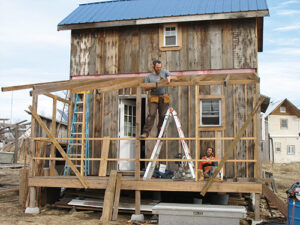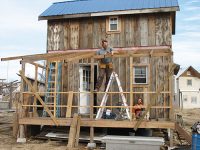 Excerpted from the Summer 2018 edition of Communities, “Eco-Building”—full issue available for download (by voluntary donation) here.
Excerpted from the Summer 2018 edition of Communities, “Eco-Building”—full issue available for download (by voluntary donation) here.
When the founders of Dancing Rabbit Ecovillage were searching for our land, they had a short list of criteria to keep in mind. The freedom to explore alternative construction was on that list, so you could say that alternative construction is written into our DNA. It was certainly a large factor in my decision to join the community (located just outside Rutledge, Missouri) in 2006.
I first visited Dancing Rabbit in fall 2005, after abandoning a MFA program studying furniture making. The next spring, I came back as a work-exchanger/intern working on the Ironweed co-op kitchen, my first chance to really get my hands dirty. Before my work-exchange was over, I was designing and collecting materials for my first building project, a 400+ sq. ft. light clay-straw insulated cabin, named Larkspur. I have had the great fortune to earn my living doing what I love working in my community ever since.
Having studied furniture making, I was no stranger to design, tools, and joinery, but I had never designed or built anything bigger than a table before. What I now know about architecture, construction techniques, natural building, and building science has come from personal experience, research, lots of reading, asking others, and a healthy dose of making it up as I go along. Even after designing and building many structures over the course of 12 years, I often feel my knowledge is woefully lacking. Please keep this in mind when selecting the grain of salt with which to take these words.
Here are some of the lessons I have learned along the way:
Yes, you can build your own house. So long as you are reasonably handy and highly motivated, there is no reason you can not pull this off. Time, money, and skill are all you need, and to be honest, you could get away with any two of those three. Even a small building project is made up of hundreds of small, discrete tasks, but most of those a trained monkey could perform. A much more important part of the construction process than experience swinging a hammer is knowing how it all needs to come together, and in what order.
You don’t have to do it alone. There is certainly something to be said about going out into the wilderness and carving out a shelter with nothing but your wits and bare hands, but there is nothing particularly heroic about solo building as a practice. In fact, it can be faster, safer, and more fun to work with other people—particularly when it comes to labor-intensive natural building techniques. If the people you enlist to help have more experience, all the better.
You don’t have to do it all. Don’t be afraid to bring in the experts. Don’t know much about plumbing? Hire that part out. Really hate working with concrete? Ditto. This will (ideally) provide you with quality work, and save you from having to become your own expert in every trade.
Keep it simple. A building project of any size is complicated. Don’t make it any more complicated than you have to, unless you really want to stretch your limits. In which case, why are you even reading this article?
Start small. If you are new to building, don’t make your first project a 1000+ sq. ft. house. Maybe start with a chicken coop, a garden shed, or a garage. You will gain real-world experience understanding the building process with significantly lower stakes.
Gain experience any way you can. Volunteer for work parties, participate in workshops. Better yet, work on someone else’s project first. You can earn money, gain experience, benefit from their experience, and ultimately not have to live with the inevitable mistakes you make.
You are going to make mistakes. There is no way around this. Your best bet is to learn from them, and not repeat them. Also, be open and honest about your failures—you may save someone else from a similar fate. May all your mistakes be small.
Prepare yourself. Building your own home will be an enormous undertaking. It will require more time, money, and materials than you think it will. I am still regularly shocked by how quickly even a small house will go through lumber.
Give careful consideration to your site. Understand the ways wind, water, sun, and shade move throughout the year on your property. Think about how your building will relate to both existing and future structures. Understand the local architectural vernacular—those design techniques have proven themselves a good match for your region. Familiarize yourself with Permaculture design, passive solar design, and consider incorporating them into your project.
Use more insulation. Code-minimum levels of insulation are simply not enough. Remember, a code-minimum construction project is the lowest quality project that can be legally built. Insulation is a great area to go above and beyond the minimums. Your building will perform better, and your energy requirements will be lower.
Reclaim materials. It is possible to save money while introducing character to your project by using reclaimed materials, whether that is lumber, flooring, lighting or plumbing fixtures. You can buy those materials from salvage companies, or salvage them yourself from dumpsters, demolition sites, or standing buildings. In my rural area, I have deconstructed many houses and outbuildings to salvage materials. Not only was I able to acquire materials at zero cost beyond my labor, but I also learned a wealth of information about how buildings are put together. As a bonus, reusing old materials in your project often adds instant charm and a sense of history.
Many ways to build. There are as many ways to build buildings as there are people building them. No two of the 100+-year-old buildings I have deconstructed were built the same way. I like to think that there is no one right way to build…unfortunately there are plenty of wrong ways.
Educate yourself. If you understand basic building science, and implement best practices in each aspect of your project, there is no reason your house won’t be standing tall in 100+ years.
Know the code. Even if building permits and inspections are not necessary where you live, it is a good idea to know what the requirements are for such things as structural elements, electrical systems, plumbing, etc. You may choose to meet those requirements, or not, but you should be familiar.
Don’t experiment for experimentation’s sake. Find out what works well in your area, and why. Talk to and learn from area builders. Then you can sit down to design a building you know will succeed. Sure, you could try to insulate your walls with plastic bottles stuffed with chicken feathers, but maybe your neighbors have had a lot of luck insulating with local strawbales. You may want to repeat their successes rather than take a chance on your experiment.
Use the Critical Path. The Critical Path is the order in which a building project comes together. What are my next steps and what do I need in order to complete them? This will help prevent you from leaving something out, or doing things out of sequence. The longer and more detailed your Critical Path the better.
Water is the enemy. Apart from cataclysmic natural disasters, most buildings eventually crumble thanks to the presence of water. Water freezing under your foundation, or being blown into your wall or roof assemblies, can make short work of your building. If you want your house to last a long time, protect it from water with a good foundation, a good roof, and careful attention to flashing and drainage details.
Buy the best quality windows you can afford. Windows and doors are very high-ticket items and it is tempting to try to save money with lower quality, or reclaimed units. My choice to install reclaimed windows in our current strawbale-insulated home may have saved us thousands of dollars during construction, but it was the single biggest mistake I made in terms of efficiency and performance. Window and door technologies are advancing so quickly that it is now possible to buy windows with insulative values as high as R-10, roughly equal to that of a 2×4 wall with fiberglass batts.
Plan for the future. Remember that your life will be changing, and your building may want to change with it. Furthermore, you want this building to outlast you. It is important to think beyond your needs right now. Think about how your home will serve you as you and your family grow, and age. Due to design restrictions, the lofted sleeping area in my first cabin was accessed by an alternating-tread staircase. That worked great for me until my son was born—but then it seemed a bit too dangerous. The second house I designed for us is a single story with doorways wide enough to accommodate a wheelchair. Take the long view.
Know what is important to you. The more you know what you like and don’t like, the more likely you are to love your new home. For instance, if you prefer to sleep in, maybe you don’t want your bedroom on the East. If you are allergic, those strawbales may not be such a good idea after all. If you love cooking, go for a bigger kitchen. If you want to do a lot of food preservation, be sure to include a pantry. Even a small office area could make working from home a reality. If you have a fondness for wood heat, by all means include a wood stove. If you hate processing and handling firewood, maybe don’t. A custom cabinet could display your extensive collection of widgits while also providing the perfect personal touch that says home.
Look for inspiration everywhere. I am constantly expanding my design vocabulary just by keeping my eyes open as I go about my day. I try to examine the buildings I interact with closely. How does this floorplan flow? What are the proportions of that window? That trim? How high is this ceiling? With the help of my ever-present sketchbook and tape measure, I can usually take note of the things that appeal to me, file them away in my brain, and pull them out the next time I am looking for a design solution.
Tony (Bear) Barrett, owner of Papa Bear’s Tiny Homes, has been designing and building at Dancing Rabbit Ecovillage in northeast Missouri since 2006. When Bear is not building, he is often seen trying to keep up with his partner, Alyssa, and their son, Zane, around the village. Their strawbale home Lobelia can be seen featured in Small Homes, by LLoyd Kahn.
Excerpted from the Summer 2018 edition of Communities, “Eco-Building”—full issue available for download (by voluntary donation) here.












